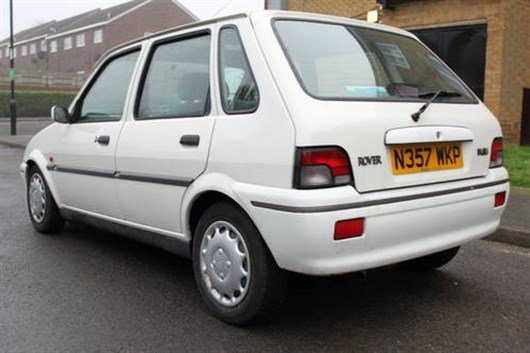A Grand Monday: Rover 114 SLi

Love it or loathe it, the Rover Metro is very much an icon of British culture. Launched (as the Austin Mini Metro) in 1980, it was a British car 'to beat the world' - and despite its antiquated A-series running gear, it was a more than worthy rival to the likes of the Ford Fiesta and Renault 5.
With Austin-Rover desperate to move away from the utilitarian days of British Leyland, the Metro was progressively improved throughout its life. Five-door models appeared in 1985, along with a revised cabin that gave the Metro a fully integrated fascia rather than the old modular instrument binnacle and Allegro/Marina switchgear that had made the first Metro feel older from the inside than it looked on the outside.
It was a strong seller, but by the time the 1980s came to an end, the Metro was woefully out of date - when launched, it was competing against the first generation of Ford Fiesta, but by 1990, it was up against the third, which was a wholly more modern car.
Of course, Rover Group (as it had become) had no budget with which to develop a brand new car, so the Metro was 'Roverised', taking the newly developed K-series engines from the new Rover 200 series (including a 1.1-litre variant developed for the Metro) and new five-speed and CVT automatic gearboxes - both long overdue.

Despite its aged underpinnings - most notable from the cramped cabin and limited glass area - the Rover Metro wasn't a bad car. Indeed, it won a number of awards from sympathetic car magazines, which still had a vestige of patriotism about them at the time. But as the Nineties progressed, so did car design.
In 1995, Rover gave the Metro its last stand, this time as the Rover 100 Series (cue Alan Partridge's famous 'They've rebadged it, you fool...' quote) and it soldiered on for another three years, by which time it wasn't just woefully, but this time painfully out of date. By the time it was put out to pasture, the 100's key rivals included the second generation Renault Clio, the fourth generation Fiesta and the brand new Peugeot 206. No matter how you tried to look at the 100, it was a product of a different era...
As a result, it was never greatly loved. But viewed in isolation, it's not a bad car. The Metro was one of the best superminis of the 1980s, and the 100 was the ultimate development of it. Also, in order to get customers into showrooms, Rover played the only card in its armoury to make the 100 attractive, which means they were frequently very well specced. Throw into the mix the fact that many 100s were bought by more mature customers, who valued buying British above all else, and there are many around that have low mileages and have been kept in cosy garages all their lives, thus avoiding the rampant rear wheel arch corrosion frequently seen on less mollycoddled Metros.
This one is the perfect example, just 35k covered from new, and less than 5000 miles aded to the odometer in the past decade. It's immaculate and has clearly been well cared for, with a clean MoT history save for an advisory over corrosion on the spare wheel carrier.

Being an SLi, it has such luxuries as a sunroof, central locking, a rev counter and a radio-cassette (what more do you need?) and comes with the CVT automatic gearbox. Apart from a reputation for being a bit snatchy when cold, the Metro/100 CVT is one of the better automatic boxes to be found in a contemporary supermini - like all CVTs it makes some fantastically weird noises, but it's set up to keep the engine revs at their peak performance, and - coupled to the 84bhp 1.4-litre engine - that makes the CVT the best performing non-performance Metro there was. It's genuinely a hoot.
At £799, It's not the cheapest on the market, but apart from being a bit low at the front (nothing a quick pump-up to the Hydragas suspension won't fix) it's probably one of the best...
- Read our Rover Metro review and buyer's guide
- How many Rover Metro's survived? Find out
- Find a Rover Metro for sale

Comments
Compare classic car insurance quotes and buy online. A friendly service offering access to a range of policies and benefits.


 Craig Cheetham
Craig Cheetham
 NEC classic motor show 2020 postponed due to Covid 19 concerns
NEC classic motor show 2020 postponed due to Covid 19 concerns
 Classic car auction house Coys goes into administration
Classic car auction house Coys goes into administration
 Motor racing great Sir Stirling Moss dies aged 90
Motor racing great Sir Stirling Moss dies aged 90
 Alfa Romeo anniversary races set for Silverstone
Alfa Romeo anniversary races set for Silverstone
 Government to make E5 fuel available for classic owners
Government to make E5 fuel available for classic owners
 Plans to introduce cleaner fuel could damage more than a million classic cars
Plans to introduce cleaner fuel could damage more than a million classic cars
 Top 10: Classic cars from the Gulf motor racing heritage collection
Top 10: Classic cars from the Gulf motor racing heritage collection











FearsomeJimny on 13 February 2017
This is the best thing ever.Chris C on 13 February 2017
It may have been outdated and not exactly crashworthy but there was a residual demand for it, partly since it was good fun to drive, and after the BMW sale MG Rover seriously looked at putting it back into production.Add a comment